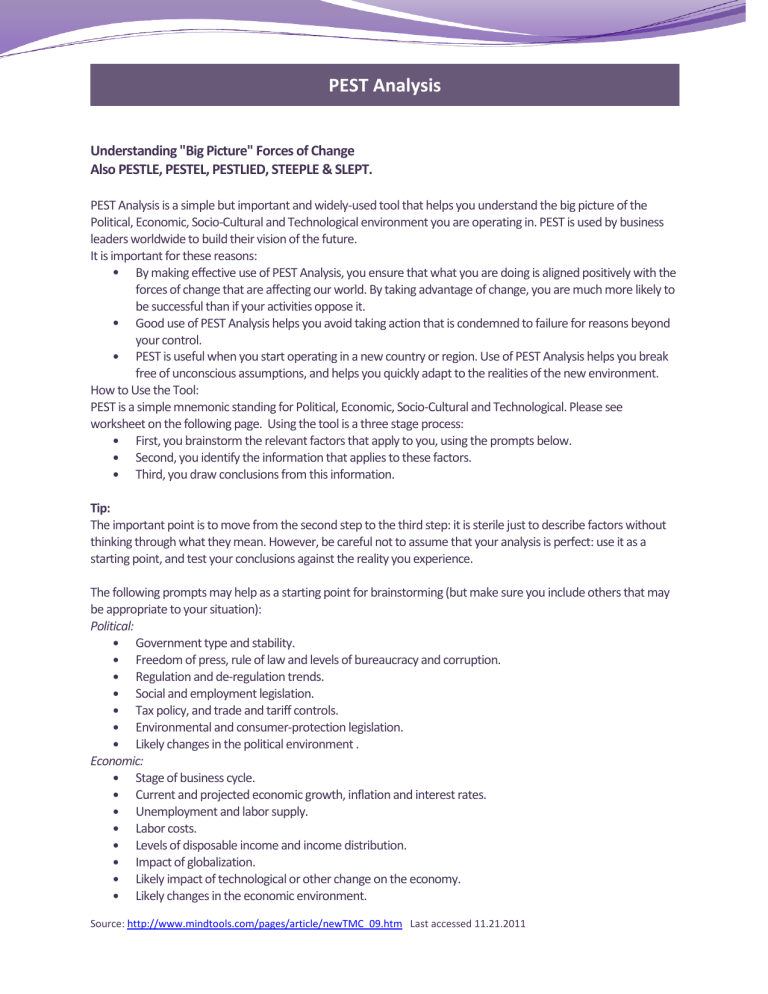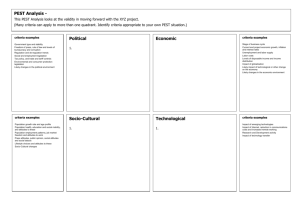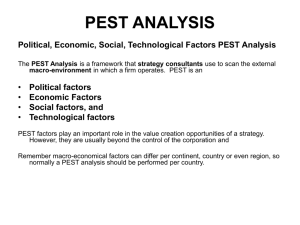
PEST Analysis Understanding "Big Picture" Forces of Change Also PESTLE, PESTEL, PESTLIED, STEEPLE & SLEPT. PEST Analysis is a simple but important and widely-used tool that helps you understand the big picture of the Political, Economic, Socio-Cultural and Technological environment you are operating in. PEST is used by business leaders worldwide to build their vision of the future. It is important for these reasons: By making effective use of PEST Analysis, you ensure that what you are doing is aligned positively with the forces of change that are affecting our world. By taking advantage of change, you are much more likely to be successful than if your activities oppose it. Good use of PEST Analysis helps you avoid taking action that is condemned to failure for reasons beyond your control. PEST is useful when you start operating in a new country or region. Use of PEST Analysis helps you break free of unconscious assumptions, and helps you quickly adapt to the realities of the new environment. How to Use the Tool: PEST is a simple mnemonic standing for Political, Economic, Socio-Cultural and Technological. Please see worksheet on the following page. Using the tool is a three stage process: First, you brainstorm the relevant factors that apply to you, using the prompts below. Second, you identify the information that applies to these factors. Third, you draw conclusions from this information. Tip: The important point is to move from the second step to the third step: it is sterile just to describe factors without thinking through what they mean. However, be careful not to assume that your analysis is perfect: use it as a starting point, and test your conclusions against the reality you experience. The following prompts may help as a starting point for brainstorming (but make sure you include others that may be appropriate to your situation): Political: Government type and stability. Freedom of press, rule of law and levels of bureaucracy and corruption. Regulation and de-regulation trends. Social and employment legislation. Tax policy, and trade and tariff controls. Environmental and consumer-protection legislation. Likely changes in the political environment . Economic: Stage of business cycle. Current and projected economic growth, inflation and interest rates. Unemployment and labor supply. Labor costs. Levels of disposable income and income distribution. Impact of globalization. Likely impact of technological or other change on the economy. Likely changes in the economic environment. Source: http://www.mindtools.com/pages/article/newTMC_09.htm Last accessed 11.21.2011 Socio-Cultural: Population growth rate and age profile. Population health, education and social mobility, and attitudes to these. Population employment patterns, job market freedom and attitudes to work. Press attitudes, public opinion, social attitudes and social taboos. Lifestyle choices and attitudes to these. Socio-cultural changes. Technological Environment: Impact of emerging technologies. Impact of Internet, reduction in communications costs and increased remote working. Research & Development activity. Impact of technology transfer. Other forms of PEST – PESTLE, PESTLIED, STEEPLE and SLEPT: Some people prefer to use different flavors of PEST Analysis. These are: PESTLE/PESTEL: Political, Economic, Sociological, Technological, Legal, Environmental. PESTLIED: Political, Economic, Social, Technological, Legal, International, Environmental, Demographic. STEEPLE: Social/Demographic, Technological, Economic, Environmental, Political, Legal, Ethical. SLEPT: Social, Legal, Economic, Political, Technological. Choose the flavor that most suits you! Key Points: PEST Analysis is a useful tool for understanding the ‘big picture’ of the environment in which you are operating, and for thinking about the opportunities and threats that lie within it. By understanding your environment, you can take advantage of the opportunities and minimize the threats. PEST is a mnemonic standing for Political, Economic, Social and Technological. These headings are used first to brainstorm the characteristics of a country or region and, from this, draw conclusions as to the significant forces of change operating within it. This provides the context within which more detailed planning can take place, so that you can take full advantage of the opportunities that present themselves. Source: http://www.mindtools.com/pages/article/newTMC_09.htm Last accessed 11.21.2011 PEST Analysis Worksheet © Mind Tools Ltd. 2006-2011 Source: http://www.mindtools.com/pages/article/newTMC_09.htm Last accessed 11.21.2011







